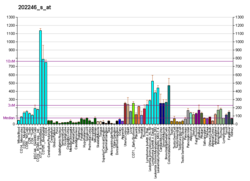| CDK4 |
|---|
 |
|
| Structures disponibles |
|---|
| PDB | Recherche d'orthologue: PDBe RCSB |
|---|
| Identifiants PDB |
|---|
2W96, 2W99, 2W9F, 2W9Z, 3G33, 5FWL, 5FWM, 5FWK |
|
|
| Identifiants |
|---|
| Aliases | CDK4 |
|---|
| IDs externes | OMIM: 123829 MGI: 88357 HomoloGene: 55429 GeneCards: CDK4 |
|---|
| Position du gène (Homme) |
|---|
 | | Chr. | Chromosome 12 humain[1] |
|---|
| | Locus | 12q14.1 | Début | 57,747,727 bp[1] |
|---|
| Fin | 57,756,013 bp[1] |
|---|
|
| Expression génétique |
|---|
| Bgee | | Humain | Souris (orthologue) |
|---|
| Fortement exprimé dans | - éminence ganglionnaire
- ventricular zone
- stromal cell of endometrium
- right adrenal gland
- right ovary
- muscle lisse
- right adrenal cortex
- left ovary
- left adrenal gland
- left adrenal cortex
|
| | | Plus de données d'expression de référence |
|
|---|
| BioGPS |  | | Plus de données d'expression de référence |
|
|---|
|
| Gene Ontology |
|---|
| Fonction moléculaire | - activité de transférase
- liaison nucléotide
- protein kinase activity
- activité kinase
- protein serine/threonine kinase activity
- cyclin-dependent protein serine/threonine kinase regulator activity
- liaison protéique
- liaison ATP
- cyclin binding
- cyclin-dependent protein serine/threonine kinase activity
- liaison de complexe macromoléculaire
| | Composant cellulaire | - cytoplasme
- cytosol
- cyclin-dependent protein kinase holoenzyme complex
- membrane nucléaire
- membrane
- transcription regulator complex
- bicellular tight junction
- nucléoplasme
- nucléole
- perinuclear region of cytoplasm
- chromatine
- noyau
- cyclin D2-CDK4 complex
- complexe macromoléculaire
| | Processus biologique | - phosphorylation
- response to testosterone
- positive regulation of fibroblast proliferation
- response to hyperoxia
- positive regulation of translation
- régulation du cycle cellulaire
- division cellulaire
- phosphorylation des protéines
- lens development in camera-type eye
- regulation of cell population proliferation
- response to lead ion
- rythme circadien
- animal organ regeneration
- positive regulation of cell population proliferation
- positive regulation of cell size
- positive regulation of apoptotic process
- régulation de l'expression des gènes
- cycle cellulaire
- positive regulation of G2/M transition of mitotic cell cycle
- réponse à une substance toxique
- positive regulation of cell cycle
- transduction de signal
- développent d'un organisme multicellulaire
- response to organic substance
- cellular response to insulin stimulus
- regulation of multicellular organism growth
- regulation of insulin receptor signaling pathway
- regulation of lipid biosynthetic process
- regulation of lipid catabolic process
- adipose tissue development
- cellular response to lipopolysaccharide
- cellular response to interleukin-4
- cellular response to phorbol 13-acetate 12-myristate
- cellular response to ionomycin
- transcription initiation from RNA polymerase II promoter
- G1/S transition of mitotic cell cycle
- regulation of cyclin-dependent protein serine/threonine kinase activity
- negative regulation of G1/S transition of mitotic cell cycle
| | Sources:Amigo / QuickGO |
|
| Orthologues |
|---|
| Espèces | Homme | Souris |
|---|
| Entrez | | |
|---|
| Ensembl | | |
|---|
| UniProt | | |
|---|
| RefSeq (mRNA) | | |
|---|
| RefSeq (protéine) | | |
|---|
| Localisation (UCSC) | Chr 12: 57.75 – 57.76 Mb | n/a |
|---|
| Publication PubMed | [2] | [3] |
|---|
|
| Wikidata |
| Voir/Editer Humain | Voir/Editer Souris |
|
La CDK4 est une kinase dépendante des cyclines. Son gène est le CDK4 situé sur le chromosome 12 humain.
Fonction de Cdk4
Le complexe Cdk4-cycline D phosphoryle la pRB, engendrant un changement conformationnel la rendant inactif, libérant E2F et permettant à la cellule de progresser dans le cycle cellulaire.
En médecine
Cette protéine joue un rôle dans la prolifération cellulaire, notamment dans les cancers[4], constituant une cible thérapeutique. Le palbociclib[5] et le ribociclib[6] sont des inhibiteurs des CDK4 et CDK6 efficaces dans certains cancers du sein.
Notes et références
- ↑ a b et c GRCh38: Ensembl release 89: ENSG00000135446 - Ensembl, May 2017
- ↑ « Publications PubMed pour l'Homme », sur National Center for Biotechnology Information, U.S. National Library of Medicine
- ↑ « Publications PubMed pour la Souris », sur National Center for Biotechnology Information, U.S. National Library of Medicine
- ↑ Hamilton E, Infante JR, Targeting CDK4/6 in patients with cancer, Cancer Treat Rev, 2016;45:129-138
- ↑ Finn RS, Crown JP, Lang I et al. The cyclin-dependent kinase 4/6 inhibitor palbociclib in combination with letrozole versus letrozole alone as first-line treatment of oestrogen receptor-positive, HER2-negative, advanced breast cancer (PALOMA-1/TRIO-18): a randomised phase 2 study, Lancet Oncol, 2015;16:25-35
- ↑ Hortobagyi GN, Stemmer SM, Burris HA et al. Ribociclib as first-line therapy for HR-positive, advanced breast cancer, N Engl J Med, 2016;375:1738-1748
 Portail de la biologie cellulaire et moléculaire
Portail de la biologie cellulaire et moléculaire  Portail de la médecine
Portail de la médecine

 Portail de la biologie cellulaire et moléculaire
Portail de la biologie cellulaire et moléculaire  Portail de la médecine
Portail de la médecine 













